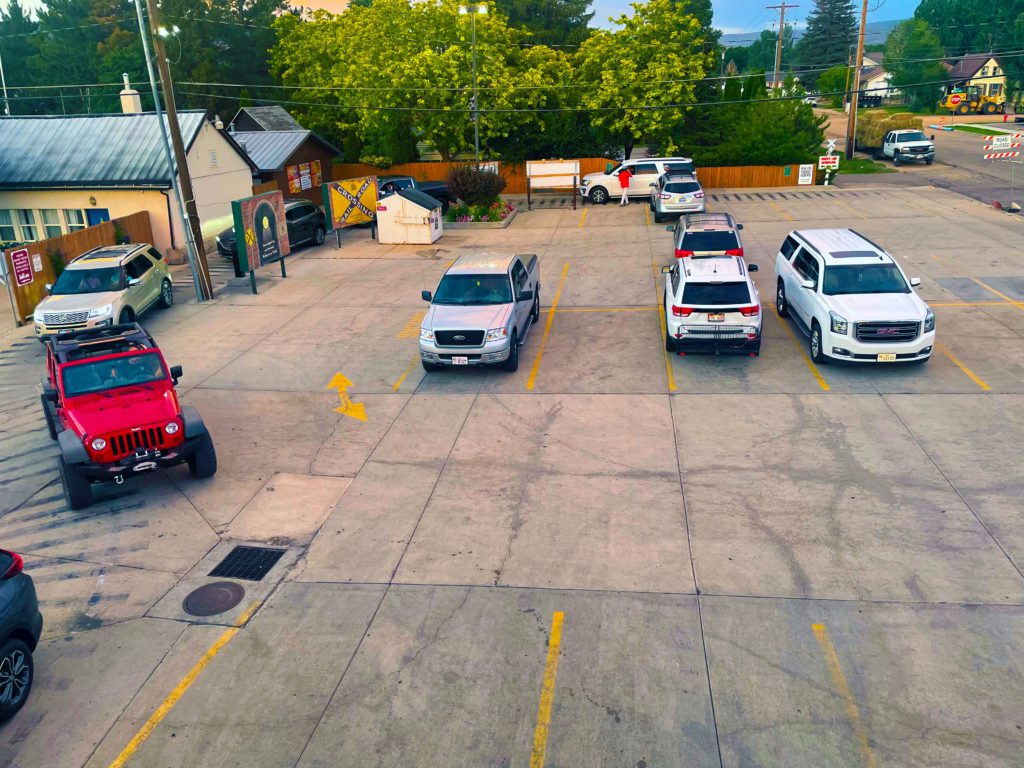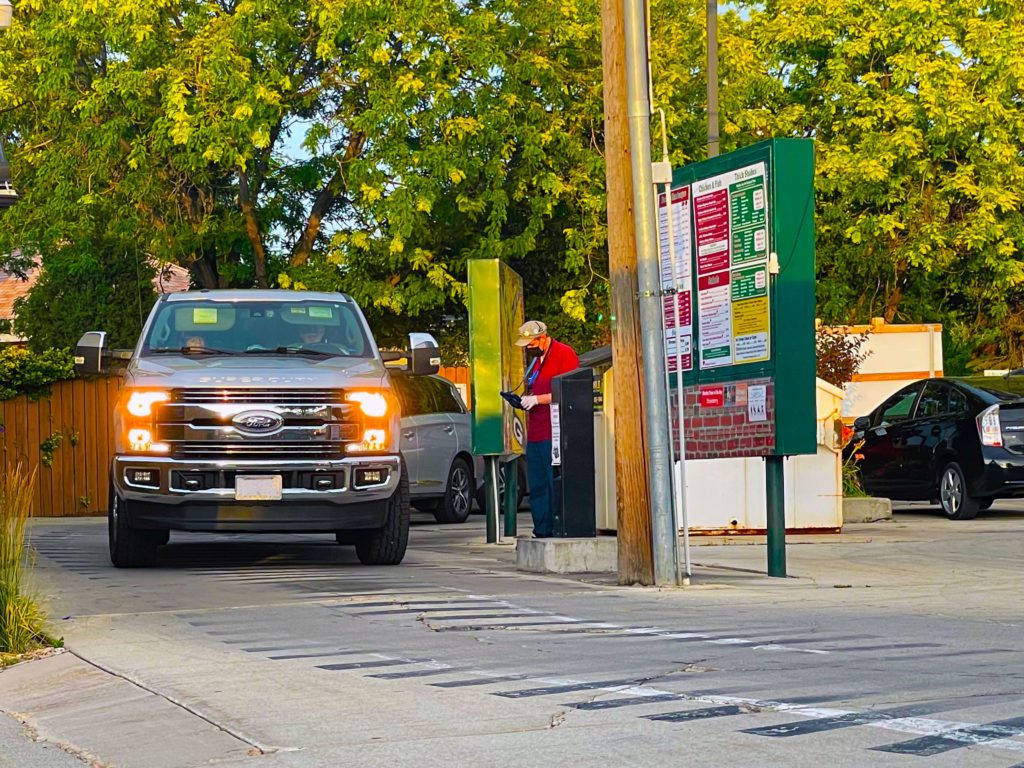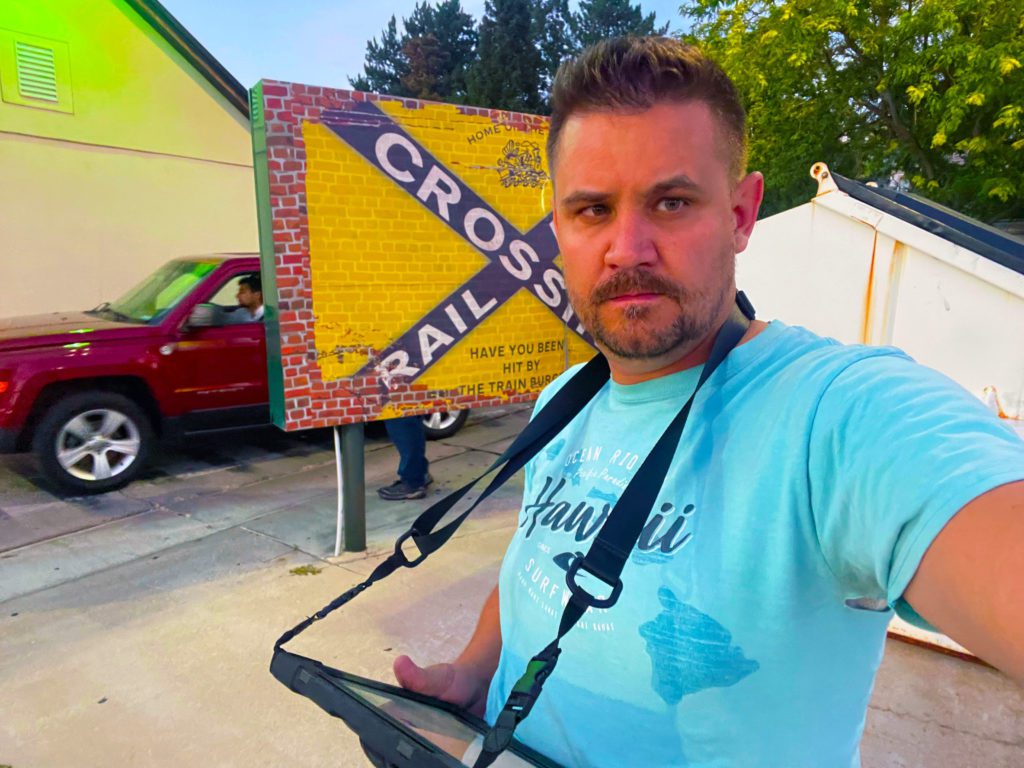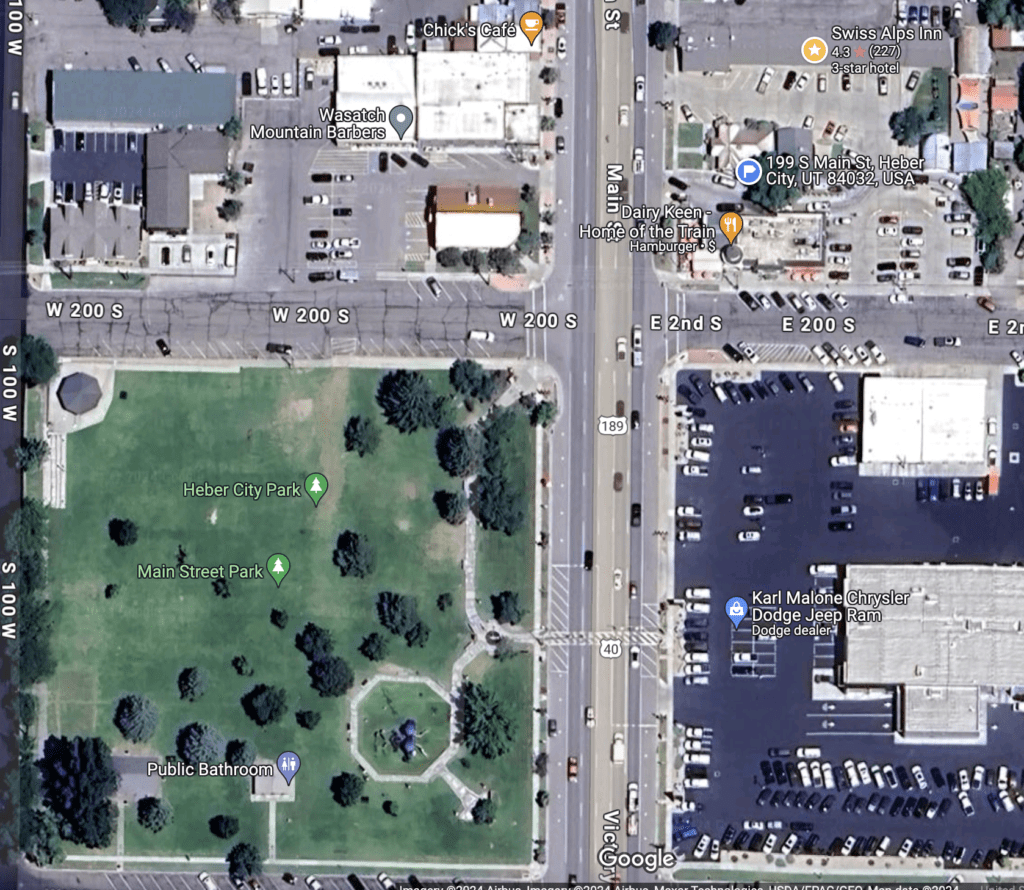My background growing up was helping run my family businesses. One of which is a fast food burger and shake restaurant. When I got interested in Private LTE, I started to think about use cases where we could use Private LTE to provide wider coverage. I have three different ideas, two of which are used for our Point of Sale system, that I’ll discuss in depth in this post. GXC provided me with their Onyx CBRS Mesh Kit that I’m using to test these use cases.

The Restaurant
In 1946, my grandparents owned the land and rented out the building for a failing Dairy Queen. My, now booming, home town at the time was small and the Dairy Queen struggled. So it eventually closed.

My grandparents thought that an open business is more profitable to sell than an empty building. So, they opened the restaurant with the intent to sell it. To save money but wanting to avoid franchising fees, they changed the sign. The QU was changed to a K, and Dairy Keen was born.

Later christened Dairy Keen – Home of the Train, because of the train that circles our ceiling, they never sold it. We have put our own flair on Burgers and Shakes and have become well known.

We continue to grow the business to millions in annual sales. It is known as a destination. People drive up to my home town from the Wasatch Front and from all over just to get a burger and shake. We have won 48 Best of State Awards Medals over the years.
The Point-of-Sale
At a previous job, right out of college in 2009, I worked for a Restaurant Point of Sale (POS) reseller. We installed the old PC Based terminals running Windows for hardwired POS terminals. We also were exploring handheld POS systems running Symbol Mobile Handhelds and Symbol Wi-Fi APs that ran 802.11b only. Those things were slow but we didn’t care so much. Our applications had low data requirements on those handhelds. Opposite to what we do today with Wi-Fi networks, we cranked those Symbol APs down to only QPSK 2 Mbps Data Rates, disabling the higher rates. We were going for distance and not throughput. Our clients wanted one AP to cover a whole restaurant, and so we designed our Wi-Fi accordingly. Wi-Fi is designed to work at even the lowest data rate and so we used it. We really didn’t know how Wi-Fi worked but heard that’s how to design these things. So we did.

Flash forward to April 2010, when Apple released their next big thing, the iPad. I know of no device that changed the POS market more than that device. About a month after the iPad went on sale to the public, I had one in hand installing it as a POS station at a client’s site. That was actually the first iPad I ever held in my own hand. Our POS vendor had an App ready to go and we were the first Point of Sale install in the state of Utah. I even got national publicity in a magazine because of it being one of the first installs with an iPad.
COVID Changes
Anyways back to CBRS, during my time working at that Restaurant POS reseller I setup the Dairy Keen with iPad POS terminals for our drive thru window. My aunt tested it out, found it be useful, but didn’t see how it solved a problem so they stopped using it. Fast forward to March 2020 and COVID, and that all changed.

Covid brought challenges to the restaurant industry as it did to everyone. Depending on where you lived, different jurisdictions placed different restrictions on restaurants. Here in Utah, we were deemed an essential business so we never had to shutdown. But over night we had to switch from counter service and drive thru service to drive thru only. Our first day running in Drive Thru only mode was a disaster. The line of cars wrapped around the block. Then a lightbulb went off in my aunt’s brain, and I got a phone call.
Since I already had the infrastructure in place from my previous testing, the cut over to Drive Thru service with iPads was a simple setup. I had it up and running day two. That has changed our business. Now about 60% of our business happens through our drive thru window. It has streamline our services.
Since March 2020, we have been running iPads to supplement our drive up service. Many restaurants with Drive Thrus have added this functionality. This is where I see CBRS helping out.
Drive Up Service with CBRS
Everyone doing Drive Thru POS curbside service right now are using Wi-Fi. Why would we consider changing to using a CBRS network? The key reasons being PCI-DSS Compliance, interference from neighbors, or reaching into large drive thru and parking lots.

PCI-DSS Security
First, CBRS out of the box is more secure than Wi-Fi. Wi-Fi can be setup to use 802.1X authentication with certificates and can reach the level of security that CBRS provides, but not out of the box. Most mom and pop shops or even larger chain restaurants aren’t using the level of security that CBRS provides. Many restaurants are using WPA2 Pre-Shared Key (PSK) on their Wi-Fi networks. If someone gets a hold of that PSK, they are easily inside the Point of Sale network. If you are taking credit cards, the Payment Card Industry (PCI) has a whole list of things you are supposed to be doing to secure that network. Having worked in the industry, most restaurants are skipping over those steps and checking a box on their annual PCI assessment. Several parts of PCI-DSS talk about Wireless technology.
1.2.3 Install perimeter firewalls between all wireless networks and the cardholder data environment, and configure these firewalls to deny or, if traffic is necessary for business purposes, permit only authorized traffic between the wireless environment and the cardholder data environment.
The industry is trying to gain control of these issues. The best solution is to not take credit cards over wireless technology and segment your network. Through the use of Square, Chipped Credit Cards, Apple Pay, and others or other purpose built terminals that encrypt traffic end-to-end, but those are not without their own vulnerabilities. A PSK Wi-Fi network is not PCI Compliant without the building of compensating controls and password length requirements. CBRS provides all of that out of the box. CBRS is out of the box covering one of the big issues with Wi-Fi, the security of the network.

GXC adds an additional compensating control. You can IPSEC Tunnel the Radios to the Onyx Edge MEC Gateway. Cellular networks already GTP tunnels the data plane traffic from the client through the radio to the core or a MEC Gateway. GXC adds the ability to encrypt that tunnel in an IPSEC tunnel. Many CBRS vendors can provide this level of protection. This is covered in PCI-DSS section 4.1. While private cellular is not included yet in the PCI-DSS annual questionnaire or recommendations, public cellular is included.
4.1 Use strong cryptography and security protocols to safeguard sensitive cardholder data during transmission over open, public networks, including the following:..
- Wireless technologies, including 802.11 and Bluetooth..
- Cellular technologies, for example, Global System for Mobile communications (GSM), Code division multiple access (CDMA)
- General Packet Radio Service (GPRS).
4.1.1 Ensure wireless networks transmitting cardholder data or connected to the cardholder data environment, use industry best practices to implement strong encryption for authentication and transmission.

This allows you to tunnel the PCI-DSS data securely across untrusted networks like the internet to say a central data center, instead of dropping the traffic off on site at the restaurant. This can provide a more end-to-end encrypted solution that is more challenging to create with a Wi-Fi network. Wi-Fi can provide this level of protection but requires more setup to change the defaults. Private Cellular has tunneling protections turned on by default. You just have to turn on encryption.
You’re also limiting the transferring of protected data over public networks, unless you cross the internet, because you’re maintaining all data within your local private network. This reduces your PCI-DSS requirements and better protects your data.
Avoiding Interference
The next piece where CBRS is superior to Wi-Fi for a Restaurant POS System is the spectrum is more challenging for neighbors or guests to cause interference.

Because of how cellular technologies are designed, unlike Wi-Fi, adding several devices together is non-blocking. This means that multiple networks can operate at the same time and the traffic is controlled and scheduled. Often a restaurant will setup a Wi-Fi network and put their POS Systems and Guest networks on the same AP. Hopefully, they use different segmented SSIDs. Guests then have the power to affect the performance of the POS System. This should not happen. Also, Rate Limiting the Wi-Fi network hurts all clients connected to the AP and should be avoided as you should watch this video from a good friend of mine. QoS and priority can be applied and guaranteed across the private cellular network at levels that are impossible to provide on Wi-Fi.
You can install a CBRS network that is dedicated for your POS System. Guests, Employees, and others can still use the existing Wi-Fi network and avoid any interference on the POS network because you’re using different spectrum channels.
Long Distance Coverage
The final reason CBRS excels over a Wi-Fi network is the range of a CBRS Network. A lot of use cases for CBRS are fitting because they provide coverage outdoors across an area that is a challenge to cover with Wi-Fi networks. You can install a CBRS Radio on the edge of a building and reach an entire very large parking lot (much bigger than ours).

Our Wi-Fi network reaches and covers the entirety of the parking lot and drive through with two Wi-Fi APs though. But sometimes during peak times, we have our drive up line of cars that extends out into the road. I’ve had employees be yelled at because customers are not served until they reach the edge of our property. They are unable to go into the road because the Wi-Fi signal drops and causes issues with the POS program.

There are business reasons for us to limit taking orders in the road, specifically safety for our employees. BUT CBRS provides the coverage that Wi-Fi struggles with. Getting Wi-Fi APs closer to that area is difficult, where the power limits of CBRS provides greater coverage areas.

When the line of cars extends into the road the signal can drop because it’s on the edge of the Wi-Fi cell. CBRS provides better coverage to extend this cell where it is needed because of the higher power levels.
CBRS for Events
Another area that I’ve always considered as a possible opportunity for testing CBRS is the city park that is southwest of our business.

Once a week during the summer months, the city has a farmers market, and on weekends other events where large numbers of people come to visit this city park. We could potentially provide coverage for our Point-of-Sale system to continue to work in a food truck during these events.

A good friend of mine, JR Rollinson, is building CBRS networks for events, including POS and other services that can be hard to cover in an event space or outdoor area. CBRS networks at events could be provided by a single business, a venue, or as a solution by a community or city. The recent Paris Olympics used Private Cellular to provide coverage for that massive event.
All food trucks today are relying on carriers providing connectivity for their Point-of-Sale systems and may use Wi-Fi to connect devices to the network. Private Cellular most likely won’t replace that in most situations, but there is a possibility for events to cover an area with private cellular and keep control of all the data in house.

Also, if you are running a large event, you can run into problems when relying on carriers for connectivity. If everyone is using their phone during a popup event, we all know how carrier networks can have issues. Providing a Private Cellular network using different bands of spectrum that is separate than what your guest users are connecting to is the best solution to guarantee connectivity for critical infrastructure.

This also can be a solution for events in remote locations where carrier networks are unavailable. Connecting a Private Cellular network to a Starlink Satellite Dish, as I discussed in a bunch of other blog posts, you can cover a whole event with a single Starlink Dish and provide coverage where it is needed.
GXC Solutions
As I talked about in my previous post about GXC CBRS Mesh solutions, GXC has an excellent portfolio of CBRS solutions that fit well with a small business needing to reach areas where Wi-Fi struggles.

As I discussed in my previous post, I’ve been playing with GXC AP and Mesh Node. This particular use case doesn’t require the usages of the Mesh Node. I just need to connect the GXC CBRS AP with antennas and Onyx Edge to my internal network and set it up in the GXC Onyx Cloud.

I can then mount the antenna on the roof of our building and point the directional sector antenna where I need coverage. There are different solutions with additional sectors or omnidirectional antennas that GXC has to provide coverage where you need it. The kit that GXC sent me only has a single sector antenna. So, I’m only able to choose to cover the parking lot or reach into the park for my testing purposes. I had to move it between the two sites for testing each use case.

Cellular Client iPads
Switching over to Private Cellular does require Cellular iPads or other cellular Point of Sale equipment, something most small businesses are not using currently. The benefit of these is that you can switch between Wi-Fi and Cellular as needed.

You can also provide both a carrier SIM and a Private Cellular SIM, although only one can be used at a time in an iPad. I also recommend you use eSIMs and MDMs to add an extra layer of security to your PCI-DSS audits.
GXC Private LTE Mesh
Although not needed for my use case, GXC’s Cellular Mesh technology could be beneficial for sites needing a larger footprint. I talked about their Mesh technology in a previous blog post. For this site and specific use case, it isn’t needed as a single radio will provide the coverage I need. That may not be the case for other use cases and sites, so I mention it again here. This also can be affected by the number of clients. The mesh node may take all resources from the park coverage.
Just showing of a quick test plan in Google Planner, we see that I could cover the park with a single radio. I could then extend the coverage into the adjacent parking lot for the Auto Car Sales business, owned by a former Utah Jazz player. Doing so would also cover my previous discussion about the drive up orders in the street and the park at the same time.

Using a secondary mesh radio, I would only need to supply a tower and power for this second radio and could cover a much larger area. No backhaul with fiber or another ISP connection is needed. As I said before, this is not needed for my use case, but it is a cool idea, provided only by GXC, if your requirements need it.
CBRS Planning at the Park
I have several modeling tools that can show the coverage at the park.

Google Network Planner
Google Network Planner is the best for showing clutter data such as buildings or trees. Sadly, new sign ups are no longer allowed for this tool. If you have access, this is my go to for outdoor planning for cheap.

Eino.ai
Next I have Eino.ai that can use AI to add clutter data such as buildings. I hope eventually they add the ability to generate trees. The benefit of Eino.ai is that you can also measure real world data if you can capture key metric data along with GPS coordinates as I discussed in a previous blog post.

Hamina
Lastly, Hamina Planner Plus added the design for Private Cellular to their tools. They currently don’t support adding clutter data automatically. So, unless you build trees or other things with their 3D design tools manually, it looks like a flat surface like this. Their 3D tools are really cool and I’m excited to see this continue to grow.

The good thing of note is that between all these tools, from a planning stage, we should have proper coverage across the park for our use case. We may even have some limited coverage behind the antenna for the drive up use case.
GXC CBRS Testing at the Park
Once I got the GXC Radio and Antennas mounted on the roof and CBRS broadcasting, I walked across the street to the City Park to test the Point-of-Sale in the park. My first testing was the day before the weekly Concert in the Park series. I wanted to see how things would work without people asking me what I was doing.
I had great signal strength just across the street and was able to test taking orders. I’m running in training mode so nothing was sent to the kitchen, but it was working as expected.

I then walked around the park testing in various locations. I didn’t have any loss of service across the park. Over by the stage where the food trucks start worked well.

Without anyone around, in the park things worked great for my testing.

Concert in the Park CBRS Event Testing
The following day was the last Concert in the Park of the summer season. We are exploring this for a possible business case next year. I tested our POS system operating over CBRS along the areas where all the food trucks are allowed and had no issues. This is a viable solution.

Ultimately, to bring this to a business use case, I would need to enable the IPSEC tunnel and work on the PCI-DSS alternate. The technology is sound and covers the requirements. Next steps are to see if the business case is worth it.
Conclusion
Using private cellular to provide coverage for a Point-of-Sale solution worked as great as I expected. Oftentimes, CBRS has been viewed as a solution looking for a problem. That may be the case in some situations, but at the same time, we’ve adapted other solutions to the problem and they may not be the best solution.

When it comes to covering a large outdoor area such as a park with wireless coverage and not wanting to rely on a carrier solution, CBRS shines bright with the higher throughputs and lower material costs. Carrier coverage may be the solution for most sites, but there are use cases where private cellular shines. GXC has built an excellent solution that makes reaching this use case cost effective. Hardwiring Wi-Fi APs around the park would be outside the abilities of my business and would rely on government funding. For my day job, I work for state government and know how challenging that can be. Private Cellular can solve this problem at a much lower price point and provide a more secure network.

